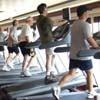Working out replaces eating out in recession
Bloomberg

refid:11440728 ilişkili resim dosyası
Scott McLin used to hit the gym about once a week. Since losing his job as a marketing analyst three months ago, he goes almost every day."I have the time now, so I may as well work on getting in shape," said McLin, 25, who’s cut back on restaurant meals and clothing purchases instead of his $86-a-month Crunch membership.
Equinox, which runs 48 U.S. gyms, and Town Sports International Holdings, the owner of the New York Sports Clubs, say that’s a growing trend as consumers grappling with the recession seek to relieve stress. In a survey released last week by the publisher of Men’s Health and Runner’s World, 84 percent of those polled said there is no better time than now to invest in health.
"Your health-club membership, your cable TV and your cell phone are in the last third of things that you’re going to cut off" in a tough economy, said Anthony Gikas, a leisure analyst at Piper Jaffray & Co.
With the unemployment rate at the highest in 25 years, consumers are taking fewer vacations and business trips, and spending less on entertainment, all of which contributes to more trips to the gym, he said.
The gym and fitness-club market will grow 2.2 percent this year to $24.3 billion, according to researcher IBISWorld. "Health and wellness tends to be a little bit more resistant to sharp declines," said George Van Horn, a senior analyst at IBISWorld in Chicago.
No price hike
Equinox, which decided not to raise dues for existing members in 2009 for the first time in its 17-year history, has added meditation classes and power-nap sessions that include stretching and end with a 15-minute nap. An Equinox membership costs between $142 and $173 a month in Manhattan.
"Staying in shape is more important than ever," Chief Operating Officer Scott Rosen said in a telephone interview. "It’s a stress relief for people."
Gym usage among existing Equinox members grew as much as 15 percent in the first quarter. Participation in classes that are included in the cost of a membership has increased by a similar amount, and the gym is adding more yoga classes to meet demand.
Christopher Stadler quit his job as vice president of marketing at a beauty-care company before the winter holidays and is now looking for a new one. He uses his Equinox membership seven days a week, up from three or four days previously.
Once a "wasteland" during the day, the gym has become "completely packed" over the past month or two, he said. "It’s an escape from headhunters and interviews," said Stadler, 38, who eats out less during the week to make up for the money he spends on his membership. Life Time Fitness, the operator of 83 gym facilities in 18 states, is also seeing increases in utilization and class attendance among existing members.
Increased usage doesn’t necessarily mean additional membership revenue for the gyms. About 35 percent of gym members plan to keep their memberships and avoid additional in-club spending, according to a bi-monthly survey by Thomas Shaw, a fitness analyst at Stifel Nicolaus & Co.
Gym usage at Crunch has increased because of the economy, said Chief Operating Officer Keith Worts. Fitness-class attendance at the New York-based chain is also up, he said.
McLin started attending classes at Crunch in San Francisco only recently, viewing them as a free personal training session that would otherwise cost $40 to $60 an hour. They’re "basically full," even at midday, he said.
"I feel so much better day to day," said McLin, who attends two classes a week and is training for a marathon.
To lure job seekers like McLin, Town Sports is using the slogan "Fact: Physically fit people are more likely to be hired." Town Sports’ club usage rose more than 15 percent in the fourth quarter, and the trend is continuing into its first quarter, Chief Executive Officer Alex Alimanestianu said on a conference call March 3.
Life Time Fitness said club openings drove a 13.6 percent increase in new memberships in the fourth quarter, compared with a year earlier.
















